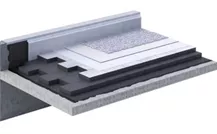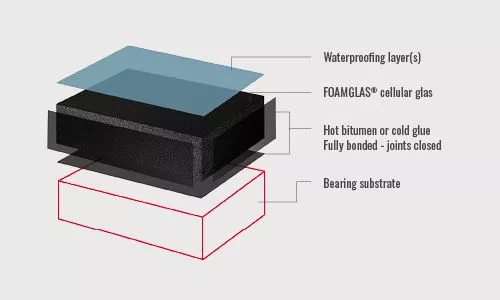Types of flat roofs
Important: the positioning of the insulation layer

With flat roofs, several options are available. Although the roof basically consists of one plane, the finish and construction can vary considerably. In particular, the positioning of the insulation layer plays an important role in distinguishing the different types of flat roofs. This also affects the top layer, where choices can include bare roofing, gravel, green roofs, and more.
Warm Roof
A warm roof is a roof type in which the insulation is placed on the outside of the roof floor, and there is no cavity ventilated with outside air between the thermal insulation and the waterproofing layer. The insulation layer in a warm roof construction acts as a substrate for the waterproofing, which is preferably adhered to the insulation. It has been proven that this type of roof provides the best results in terms of thermal efficiency, longevity, and simplicity of construction. The FOAMGLAS® Compact Roof is a warm roof where all layers are fully bonded with hot bitumen or cold glue.
Cold Roof
A cold roof is a roof structure in which there is a cavity ventilated with outside air between the roof floor and the insulation. This build-up can cause significant damage due to internal condensation and the rotting of any wooden roof decking.
Therefore, this type of roof is not recommended for new construction. During renovation projects, they are often converted into warm roofs.
Inverted Roof
An inverted roof is a special type of flat roof where the insulation is loosely laid on top of the waterproofing. Specific types of insulation have to be used in this roof type. To prevent internal condensation, it is recommended to increase the insulation thickness by at least 20%. This means using at least 45 mm of dry insulation material and a drainage layer with a small air cavity. The BDA (Building Designers Association) recommends against applying a green roof finish to an inverted roof due to the risk of internal condensation.
Compact Roof
A compact roof is a type of warm-roof construction that utilizes a two-layer bitumen membrane. Unlike traditional warm-roof construction, all layers in a compact roof are homogeneously connected, including the substrate, which eliminates the risk of water flooding. The concept of a compact roof can be confusing when constructing flat roofs. FOAMGLAS® insulation has been successfully used in compact roof solutions for over 50 years.
However, the FOAMGLAS® Compact Roof stands out from other so-called compact roofs.
With FOAMGLAS®, the insulation is fully adhered to the structure, and the roof waterproofing is applied directly to the insulation. This construction has a proven long service life.
Another type of compact roof that emerged in the early 21st century is a wooden structure completely filled with insulation material. This roof structure is similar to a cold roof because it lacks a layer of air, which can lead to well-known problems. The technical regulations for constructing such flat roofs highlight the numerous risks involved. Designing and implementing this type of roof structure requires specific expertise, approach, and experience. Therefore, it is generally not recommended to use the wooden compact roof (timber structure).
The key distinction between a FOAMGLAS® Compact Roof and a compact roof with a timber structure lies in the fact that the FOAMGLAS® Compact Roof is a pure warm-roof structure with proven results and no building physics risks. On the other hand, the compact roof with a timber structure raises multiple concerns and often leads to building physics risks. Various instances of damage and recommendations clearly indicate the risks associated with this structure, especially when combined with green roofs.
In summary, it is crucial to demand and provide high-quality products and installations to enhance the lifespan of thermally insulated flat roofs. The underlying philosophy behind roof structures is to combine economic efficiency and ecology. With careful consideration and proper installation, green roofs can serve as a sustainable and efficient solution for flat roof construction.



